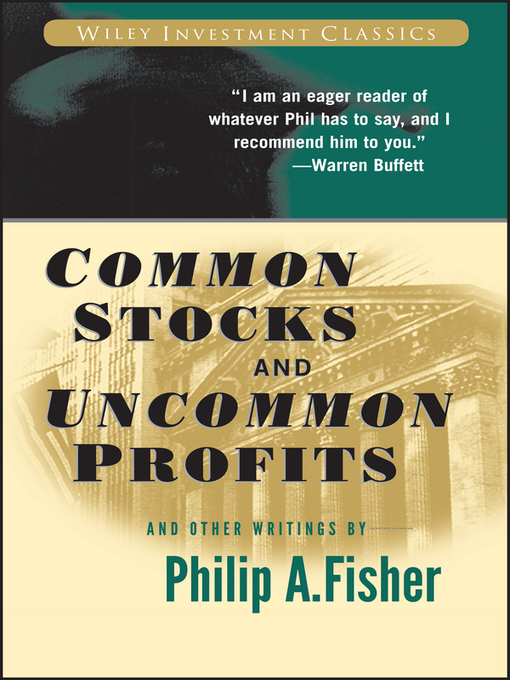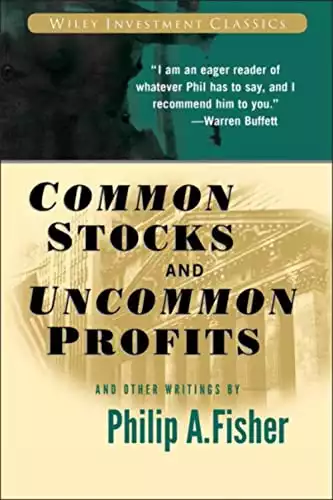Overview : Common Stocks and Uncommon Profits
-
Book Title: Common Stocks and Uncommon Profits
-
Author: Philip A. Fisher
-
Publication Date: 1958
-
Rating: 4.5
-
price: $14.89
-
Pages: 320
About the Author
Philip Fisher, a pioneer in growth investing, is the author of Common Stocks and Uncommon Profits. With decades of experience in the stock market, Fisher's insights on long-term investment strategies have profoundly influenced modern investors, including legends like Warren Buffett.
Introduction to Common Stocks and Uncommon Profits
In the ever-evolving world of finance and investing, few books have stood the test of time quite like Philip Fisher's "Common Stocks and Uncommon Profits." First published in 1958, this seminal work continues to shape the strategies of both novice and seasoned investors alike. With its focus on qualitative analysis and long-term growth potential, Fisher's approach offers a refreshing perspective in an era often dominated by short-term thinking and algorithmic trading
For finance professionals, Fisher's insights are invaluable. His methodologies, including the famous "scuttlebutt" method, provide practical tools for identifying high-quality investments with strong growth prospects. As the financial landscape evolves, the principles outlined in Common Stocks and Uncommon Profits remain relevant, making it a crucial read for those looking to deepen their understanding of investment strategies and enhance their decision-making processes.
Common Stocks and Uncommon Profits Book Summary
At its core, "Common Stocks and Uncommon Profits" presents a comprehensive framework for identifying high-quality companies with strong growth prospects. Fisher's methodology, which he terms the "Scuttlebutt" approach, involves gathering information from various sources beyond just financial statements. This includes talking to competitors, suppliers, and even employees to gain a holistic understanding of a company's potential.
Fisher outlines 15 points that investors should consider when evaluating stocks, emphasizing factors such as:
- A company's ability to grow sales and profits
- The effectiveness of research and development efforts
- The quality and integrity of management
- The company's competitive position in its industry
These points form the foundation of what has come to be known as growth investing, a strategy that focuses on companies expected to outperform the overall market.
Analysis of Key Themes
Qualitative Analysis in Investing
One of Fisher's most significant contributions to investment theory is his emphasis on qualitative factors. While many of his contemporaries focused solely on financial metrics, Fisher argued that understanding a company's intangible assets - such as its corporate culture, innovation capacity, and management quality - was crucial for long-term success.
The Power of Long-Term Investing
Fisher was a staunch advocate for patience in investing. He believed that the greatest returns come from holding onto high-quality stocks for extended periods, allowing compound interest to work its magic. This approach stands in stark contrast to the frequent trading that characterizes much of today's market activity.
Innovation and Adaptability
In an era where technological disruption is the norm, Fisher's insights on the importance of innovation remain incredibly relevant. He stressed the need for companies to continually adapt and evolve, a principle that has become even more critical in today's fast-paced business environment.
Writing Style and Accessibility
Fisher's writing is clear and straightforward, making complex investment concepts accessible to a wide audience. While the book was written over six decades ago, its language and examples remain surprisingly relevant. Fisher's use of real-world case studies helps illustrate his points and provides practical applications of his theories.
Strengths and Weaknesses of Common Stocks and Uncommon Profits
Strengths:
- Timeless investment principles that have proven effective over decades
- Comprehensive framework for evaluating stocks beyond just financial metrics
- Emphasis on long-term thinking and patience in investing
Weaknesses:
- Some examples and case studies may feel dated to modern readers
- The book predates modern financial instruments and market structures, requiring readers to extrapolate principles to today's environment
Related Books to Common Stocks and Uncommon Profits
While "Common Stocks and Uncommon Profits" shares some similarities with Benjamin Graham's "The Intelligent Investor" in its focus on fundamental analysis, Fisher's approach is distinctly more growth-oriented. Unlike Graham's emphasis on finding undervalued stocks, Fisher encourages investors to seek out high-quality companies with strong growth potential, even if they appear fairly valued or slightly overvalued in the short term.
Compared to more recent works like Peter Lynch's "One Up on Wall Street," Fisher's book provides a more structured framework for analysis but lacks the more casual, anecdotal style that some modern readers might prefer.
Relevance to Modern Investing
Despite being written in the 1950s, many of Fisher's principles remain highly relevant to today's investment landscape. His emphasis on understanding a company's competitive advantages and growth potential aligns well with the success of many modern tech giants. Furthermore, Fisher's "Scuttlebutt" method of information gathering can be seen as a precursor to the mosaic theory used by many contemporary analysts.
In an era of high-frequency trading and market volatility, Fisher's advocacy for patient, long-term investing offers a valuable counterpoint to short-term thinking. His insights on the importance of management quality and corporate culture are particularly pertinent in today's business environment, where factors like employee satisfaction and ethical leadership can significantly impact a company's performance.
Highlights from Common Stocks and Uncommon Profits by Philip Fisher
Focus on Quality Growth Stocks: Invest in companies with strong growth potential, not just undervalued stocks.
Management Integrity: Prioritize companies led by honest, capable management with a clear, long-term vision.
Competitive Advantage: Look for businesses with unique products or services that set them apart from competitors.
Research Thoroughly: Conduct in-depth research, including talking to industry experts, employees, and customers, to understand a company’s strengths.
Long-Term Holding: Emphasizes the value of holding quality stocks for the long term to maximize returns.
Avoid Over-Diversification: Focus on a few well-chosen stocks rather than over-diversifying for better gains.
Conclusion
"Common Stocks and Uncommon Profits" remains an essential read for anyone serious about investing. Philip Fisher's insights into qualitative analysis, growth investing, and the importance of patience have influenced generations of investors, including Warren Buffett himself. While some aspects of the book may feel dated, the core principles it espouses are as relevant today as they were in 1958.
For both novice investors looking to build a solid foundation and experienced traders seeking to refine their strategies, Fisher's work offers invaluable guidance. In a world where market noise and short-term thinking often dominate, "Common Stocks and Uncommon Profits" serves as a timeless reminder of the power of thoughtful, long-term investing.





